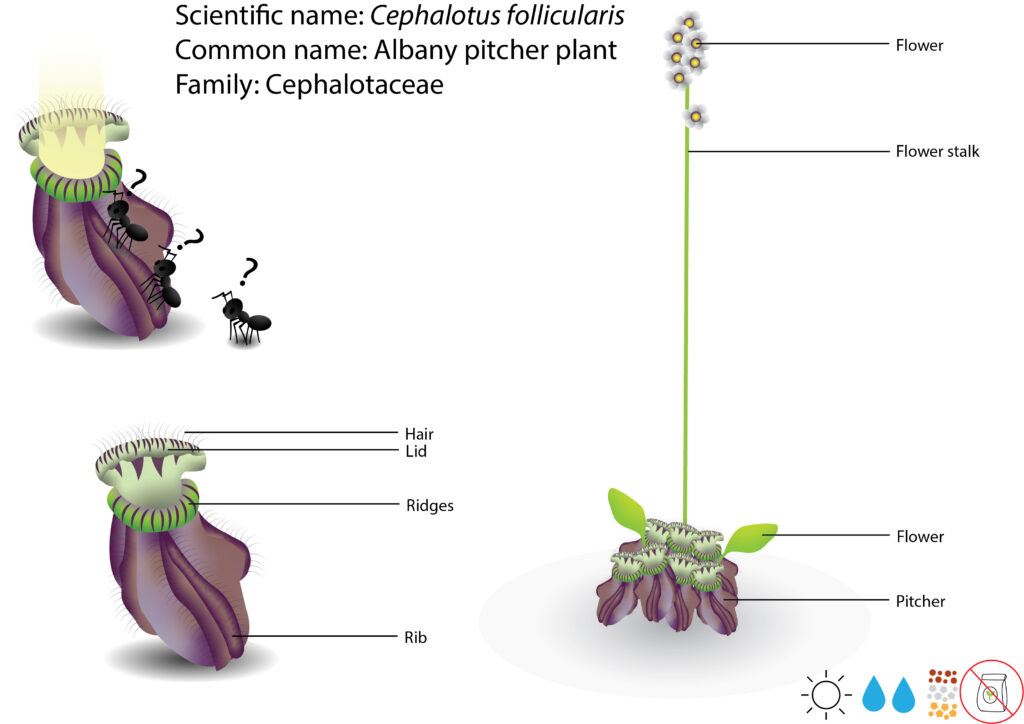Background
The smallest carnivorous pitcher is the west Australian pitcher plant, Cephalotus follicularis. It is one of the most desired carnivorous plants in the collection as well as cultivation. Cephalotus is a thumb-size pitcher of compact growth up to two inches long with colorful and bristly pitchers that are seemingly yawning for a bite to eat. It is a monotypic genus under the family of Cephalotaceae that is commonly referred to as the Albany pitcher plant. It is a small and slow-growing herbaceous species that grow naturally in a narrow coastal strip around Esperance Bay in extreme southwestern Australia.
Morphology
This tiny creature produces two primary forms of leaves, mainly non-carnivorous leaves and carnivorous leaves from a tan-colored rhizome. The non-carnivorous is characterized by pointed but oval leaves which is rich and shiny green color connected with a short petiole. They carry out photosynthesis when the daytime is longer in spring. Whereas the modified carnivorous leaves develop into tiny pitchers. They start as fuzzy knobs at the ends of the elongating petioles that slowly inflate and swollen which eventually form hollow pitchers. The hollow pitchers have a rain-protecting lid hanging over the mouth that is similar to some species of Nepenthes. This is to prevent the rainwater from diluting and overflooding the little containers. During the summer, it produces clumps of flowers with a very long stalk that looks running away from the pitchers.
Propagation and caring tips
Cephalotus can be self- and cross-pollinated for seed production using a paintbrush. However, germination of the seeds is not favored because the seedlings grow very slow and the seeds do not remain viable for long. Seed stratification is needed prior to seed germination. It is more common to propagate through the division of crowns, leaf cuttings that use the leaves with whitish lead base, and root cuttings on the rhizome of mature plants. Cephalotus do not appreciate waterlogged conditions the same as Byblis and Nepenthes. It grows in permanently acidic damp and sunny conditions such as the edges of swamps with cool summer. In the sun, Cephalotus develop red and purple coloration that is similar to certain species of Sarracenia, Heliamphora, and Darlingtonia. It remains green in shaded conditions or when the light is insufficient for growing.
Preying mechanisms
The preying mechanisms of Cephalotus are also similar to other pitcher plants which are the trapping mechanism or pitfall. It has hairy bristles grow on the lid and along the three rows of the ribs on the pitcher’s front. The hairs act as the “ladder”, or “guide hairs” that guide and lead the insect toward the open mouth. The preys are usually small ants and lured by the nectar glands located in the inner wall of the tiny pitchers. There is a ridge of shape and incurved teeth at the mouth of the tubular pitchers of the Cephalotus which is also observed in some Nepenthes species. The highest concentration of the nectar is at the base of these “teeth”. The insects and the prey are attracted and would lean over the waxy and slippery teeth to get a better taste, which cost their life by falling into the traps!
Similar to other pitchers, it has downward pointed hairs to prevent prey from climbing out. Furthermore, the overhanging collar makes the escape impossible. The lid allows the projection of light which creates transparent light windows on the lid which is unique that is different from that of Darlingtonia and some Sarracenia. This creates an optical illusion of the depths of the trap that are more inviting to insects as the light shines on the pool of digestive juices. Interestingly, the lid of the pitchers will slowly fold downward in drying conditions that known as a wilting response to cover their mouth and reduce the evaporation of the digestive juices inside the containers. However, it considered as has no real significance.

Swenson, A. A. (1977). Cultivating carnivorous plants. Doubleday.
Temple, P. (1988). Carnivorous plants.
Pietropaolo, J., Pietropaolo, P. A., & James. Pietropaolo. (1999). Carnivorous plants of the world. Timber Press.
D’amato, P. (2013). The savage garden, revised: Cultivating carnivorous plants. Ten Speed Press.
Ellison, A. M., & Adamec, L. (Eds.). (2018). Carnivorous Plants: physiology, ecology, and evolution. Oxford University Press.